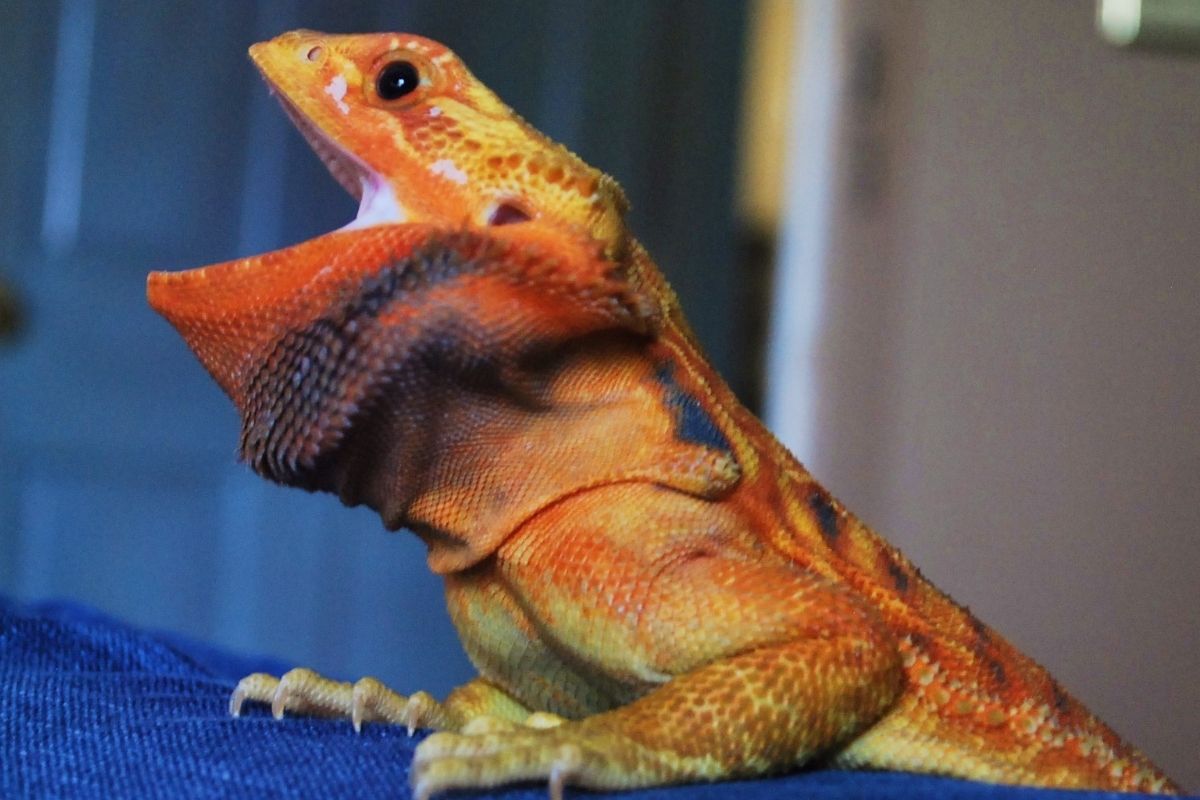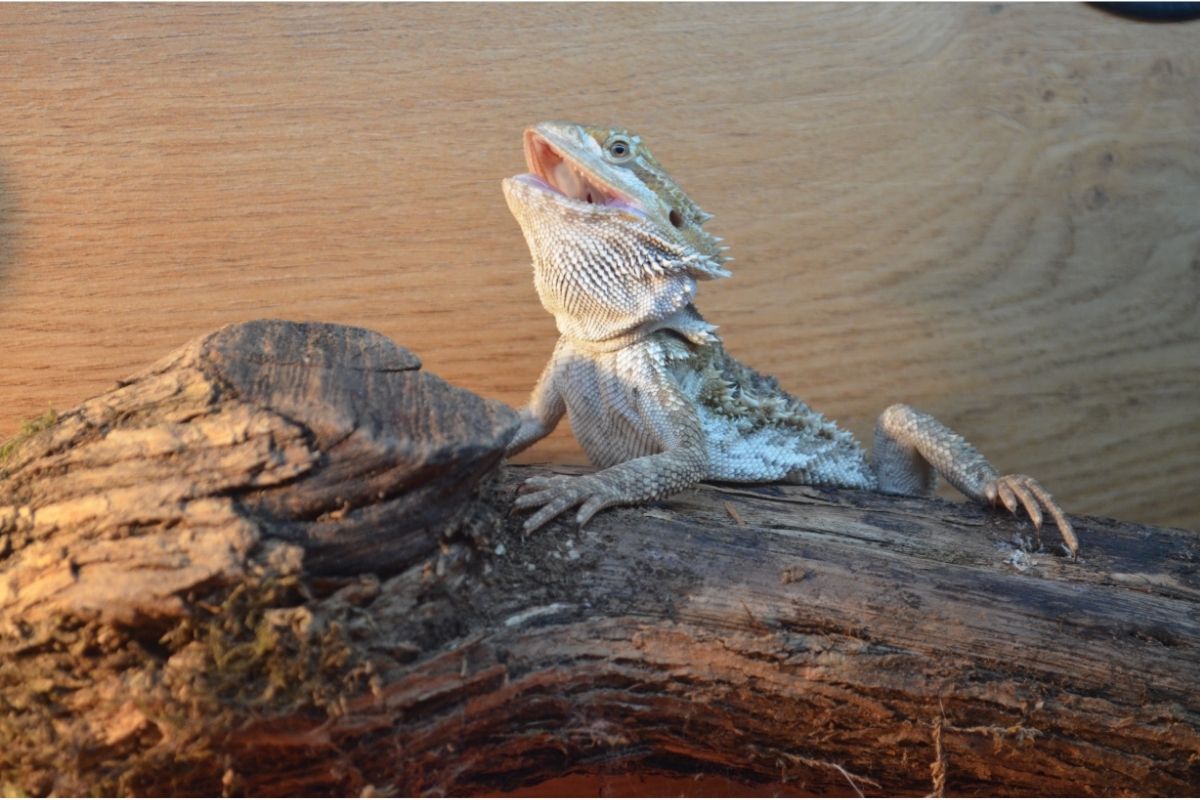Almost all animals make noise, whether it is a dog barking or a snake hissing.
All creatures have the ability to emit sounds to communicate with one another.

Bearded dragons do not have vocal cords, so they make a limited number of noises, which they make using their limbs or tongue.
Bearded dragons communicate with one another through body language.
While they mostly communicate through body language, there are still specific actions that they will make to create a noise.
Some of these actions don’t mean anything in particular, but some are warning signals or could show that your bearded dragon is in distress or unwell.
While some of these actions may be silent, they are still trying to communicate with another creature, and in some cases, as mentioned above, they will make specific noises using their limbs or tongue.
Below we look at what their body language means and the few sounds that bearded dragons do make.
Knowing what these sounds and physical actions mean will allow you to look after your pet to the best of your ability.
What A Bearded Dragon’s Body Language Means
Bearded dragons don’t often make noise and so it is important that you can read and understand their body language so you can understand how your pet is feeling and what it is that they might need.
The body language that bearded dragons use is perfectly suited to their lives in the wild.
They are extremely territorial creatures and have fantastic eyesight meaning they can spot an intruder and communicate with them from some distance away.
Below we look at the most common actions bearded dragons make and what they mean.
Head Bobbing
Bearded Dragons bob their head to show one of two things, either they are asserting their dominance or they are showing to other bearded dragons around that they are ready to mate.
This action is typically seen in the wild or if you were to add a new statue into your bearded dragon’s tank.
Waving Hands
The internet is filled with funny videos of bearded dragons waving, but there is a reason behind this action and it is to show submission.
Bearded dragons wave their arms to acknowledge a more dominant bearded dragon and prevent any need for fighting to assert dominance, especially between two males.
Changing Color
Most people assume that only Chameleons can change color. However, bearded dragons have the ability to make their coloring darker or lighter.
An example of this is that bearded dragons color their beard a darker, almost black, color to show they feel discomfort.
If they are in a situation where mating could happen, they also darken their beards during this process.
Beard Puffing
Beard puffing is similar to the hair standing up on a cat’s back. It is a very aggressive bodily reaction that bearded dragons exhibit when they are showing aggression towards something in particular.
If you are holding or bathing your bearded dragon and it begins to show this action, you should put it back in its tank or keep your distance until it calms down.
Raised Tail
When a bearded dragon becomes alert, it raises its tail. This is also a sign of excitement.
In the wild, a bearded dragon’s tail would often be raised as it would be alert to its surroundings as it hunts for food.
Body Flattening
A bearded dragon flattening its body is never a good sign, as this means they are trying to get more heat from the surface they are lying on.
If you see your bearded dragon doing this, make sure you raise the ambient temperature to prevent your pet from becoming stressed or unwell.
The above highlights the many ways bearded dragons can communicate without making a sound.
Next, let’s take a look at some of the sounds that you could expect to hear from your bearded dragon’s glass tank on occasion.
It is worth noting that all the sounds that bearded dragons make will be combined with powerful body language, making them easy to recognize and understand.
What Sounds Made By Bearded Dragons Mean

There are four main sounds that you can expect to hear from your bearded dragon.
Your pet may emit the noise themselves, or they may use actions to create the noise.
Continue below to learn more about what your bearded dragon may sound like on occasion!
Hissing Sounds
A hissing sound is the most common noise that bearded dragons make.
This sound is often combined with a powerful stance to scare threats or other creatures away.
While it may seem like aggressive behavior, it is, in fact, a defensive behavior that bearded dragons use to protect both themselves and their territory.
Bearded dragons are not very aggressive and tend not to attack suddenly. Usually, it would be their last option if they found themselves in danger.
If a bearded dragon hisses and you approach or touch it, in most cases, you will get bitten or get a hard slap from the creature’s tail.
With this hissing noise, you can expect that they will darken their beards and puff up their bodies to seem larger and more intimidating.
If your bearded dragon lives a peaceful life, then you may never hear it hiss as it is relaxed and calm the majority of the time.
Glass Scratching Or Surfing
Glass scratching, or surfing as it is sometimes called, is a behavior seen only in bearded dragons that are pets.
They scratch the glass of their tank, and this could be for a number of reasons.
The first reason is that they may have seen an insect flying around the room outside their tank, and they are trying to get at it.
Most people interpret this action as a bearded dragon showing they are unhappy in their tank and trying to escape but another reason for this action is that a bearded dragon has learned that the noise of their scratching gets their owner’s attention, and they are then let out of their tank, or the owner might be reminded to feed them.
Digging
Digging is a very natural behavior in bearded dragons as in the wild, they would often dig to create their habitats, such as a cave, which they would then bury themselves into to protect themselves from predators, particularly at nighttime.
Digging should be encouraged, so it is important that you have the correct substrate in the tank and that you are feeding your pet a balanced diet, sometimes bearded dragons can eat the substrate, such as sand, and become unwell, but they only do this if they are looking to get more minerals.
A clay mix substrate is a great choice as it allows your bearded dragon to dig and it is something that they would tend not to eat.
Respiratory Noises Such As Coughing
When a bearded dragon is sick, often you will be able to notice due to the noises they make, such as weak hissing noises, noisy breathing, coughing, or in some cases choking.
Lung inflammation is an illness that has all of the above symptoms, and so if your pet is showing any of these symptoms, you should go to a veterinarian as soon as possible.
Even if it is not lung inflammation, it could be a parasitic infection or a yellow fungus disease.
Don’t Forget The Food!
If you are feeding your bearded dragon live food, this can often be noisy.
Most bearded dragons like crickets, and feeding them live crickets help a bearded dragon to maintain its natural instincts.
If you put multiple crickets in the tank at once you may have to put up with the noise for a while as crickets can be extremely noisy creatures.
If the noise of the crickets is annoying you, try substituting this live food for Dubai roaches. They are healthy for your pet and totally silent.
Frequently Asked Questions
Do Bearded Dragons Make Noise During The Nighttime?
Bearded dragons are diurnal creatures, which means that they sleep during the night and are alert during the day.
As a result, it is very rare that you would hear any movement or noise from your bearded dragon’s tent during the night as they sleep very still.
It is because of this that many people choose to have their bearded dragons kept in their bedrooms.
That way they can have company in their bedroom and not have to worry about being woken up during the night, which would typically happen if you had a noisier animal as a pet.
Why Does A Bearded Dragon Have No Vocal Cords?
Most reptiles do not have vocal cords as a result of evolution.
Reptiles have used their bodies to communicate as often they live in environments where they need to be quiet, so they don’t get attacked by larger predators.
The only reptile that has vocal cords are geckos.
Even though these creatures have vocal cords, they still remain very silent the majority of the time.
Final Thoughts
Now that you understand the noises that your bearded dragon may make as well as how to understand their body language you will be able to look after your bearded dragon’s every need as they will in a sense be able to communicate with you faultlessly.
If you notice that your bearded dragon is making new, unusual noises it is best to speak to your local veterinarian for advice about these new sounds.
They will be able to let you know what may be the problem and offer a solution so you can have your bearded dragon back to peak health again in no time.
